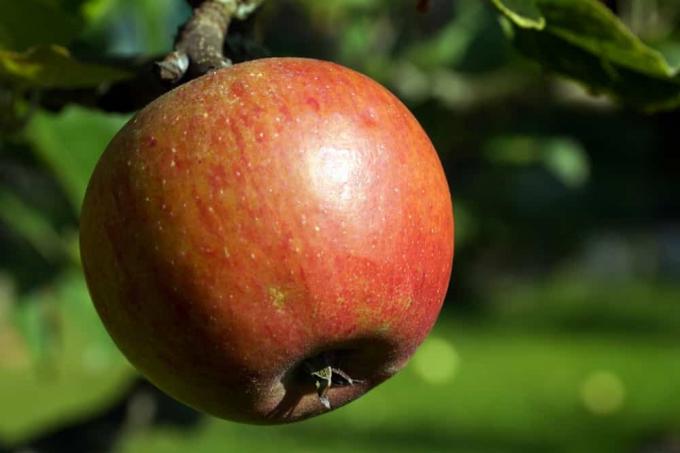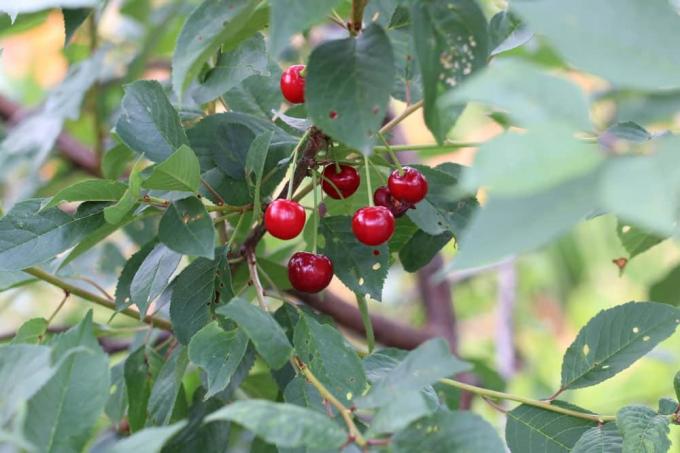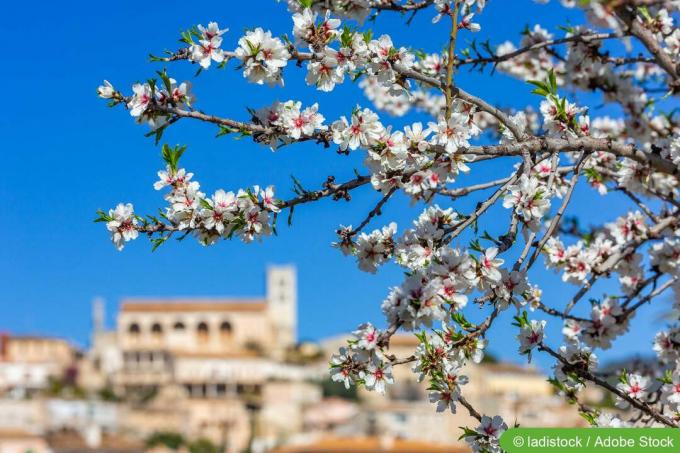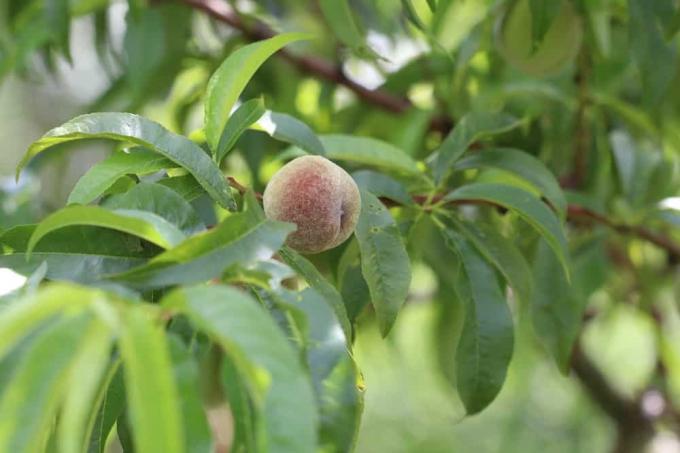

Table of contents
- Tip for the location
- Best planting time
- Cultivation Tips
- Tips for repotting small fruit trees
- Tips for watering small fruit trees
- Tips for fertilizing small fruit trees
- Tips for pruning small fruit trees
- Tips for the right hibernation
- Tips on diseases and pests
Tall, old fruit trees conjure up a special charm in every garden. But they usually not only make a lot of dirt, they also take up space. This is not available to everyone. Dwarf fruit trees and columnar fruit trees offer a perfect alternative here, but they differ from their larger counterparts in some respects in terms of the care they require. Expert tips ensure that your specimen develops magnificently.
Tip for the location
Whether bushy or growing slender as a column, small fruit trees take up little space. Especially when they are cultivated in pots, they also fit on the smallest balcony. However, the location is not optimally selected and means that you have to pay more attention to the plant when caring for it. If you plant a dwarf fruit tree in the garden bed, it requires no more care than a normal, large fruit tree of the same species.
Otherwise, the following site properties are sufficient for planted and cultivated dwarf fruit trees:
- nutrient-rich soil
- Sunny place
Best planting time
For hardy small fruit trees, the best time of year to plant is fall. They can settle well by spring and start growing right away in the next season. Young plants should be provided with winter protection over the winter. (See also: Tips for correct wintering)
Cultivation Tips

When planting in a bucket, a few factors should be considered so that small fruit trees thrive strong, healthy and with a good harvest.
pot/tub size
With small fruit trees, it is very important that their roots can spread unhindered. For this reason, it is recommended to choose a pot that is around 30 liters in size. Basically, the larger the pot/tub, the better the plant can develop.
Pot/tub properties
Only use a pot/tub that has a drainage hole. Excess water and rainwater can drain off through this. The formation of waterlogging can be prevented in this way, which quickly makes small fruit trees ill and negatively affects fruit formation.
drainage
At the bottom of the pot/bucket, a two to five centimeter layer of gravel, quartz sand or potsherds provides drainage. This also reduces the risk of waterlogging.
potting soil
While fruit trees in the garden usually do not make great demands on the soil conditions, small fruit trees in pots/tubs should meet several conditions. This is due to the fact that the roots of outdoor trees can feed themselves from the soil much more extensively. With potted plants, they depend on what you provide them with. The following tips should be considered for pot and bucket soil:
- Mixture of conventional potting soil, high-quality substrate and a little sand
- Particularly nutritious
- Horn shavings improve the long-term supply of nutrients
- Incorporated bark mulch allows the soil to dry out more slowly
Tips for repotting small fruit trees
frequency
A small fruit tree should be repotted in completely fresh soil every three to five years. A slender growing columnar fruit tree is repotted about every four years. The prerequisite is that the plants have enough space in the old pot/tub by then. If this is not the case, or if a disease makes repotting necessary, this is of course preferable. Once a year replacing the top layer of soil is beneficial.
cutting roots
Repotting is the ideal moment to cut the roots of a small fruit tree. Pruning is recommended because it strengthens the roots and allows them to continue growing vigorously. But be careful, because cutting the roots too hard can affect the shape of the crown. A few centimeters are sufficient. Above all, excessive pruning of thick roots should be avoided. Here you should only cut off the tips. The root cut has been optimally successful if they have a distance of between three and five centimeters from the pot/bucket in all directions.
Tips for watering small fruit trees

A small fruit tree dries much faster in a bucket than in the garden soil, where it may still be stands next to shady plants, which make the ground environment more spacious and humid hold. For this reason, the cultivated fruit tree usually has a noticeably higher water requirement. A daily check is mandatory in summer, since drying out can quickly lead to dehydration in the small specimens and this can have a serious impact on growth. To find out the right moment for watering, you can do the following:
- Fingers in the ground
- If it can be pressed in less than two centimeters - watering required
- If it can be pressed in more than two centimeters – no need for watering
Tips for fertilizing small fruit trees
Garden saplings in the ground do not need to be fertilized often. A little compost each spring supports healthy growth.
In the case of potted plants, however, fertilizing is advisable, as described below:
- March/April fertilization with special fruit fertilizer
- Fertilize in June
- Do not fertilize later than August, otherwise the lignification in autumn will not be ideal
Tips for pruning small fruit trees
dwarf fruit trees
In contrast to the large conspecifics, dwarf fruit trees are cut more frequently and shorter. Various suitable pruning techniques refer to those of the conventional fruit tree and are similar to those used in bonsai care.
- The first cut is always made shortly before the shoots sprout
- Regularly trim any branches that are crossing, parallel, or not growing outward (encourages dense growth and harvesting)
- Always cut above buds - never between two buds (increases the risk of infection)
- Do not prune the lower crown area initially (ensures thicker branches)
- Last cut in August at the latest so that the hardening of the wood works optimally in the autumn
- Seal cuts with charcoal powder or special wound resin from specialist shops
columnar fruit trees
Unlike dwarf fruit trees, these need to be pruned significantly less. They usually keep their slim form. However, should cutting become necessary, follow the instructions below:
- Cut back shoots to a maximum of ten centimeters in length
- If the center drive is too large, shorten it to the desired height
- Cut only in summer and/or winter
Tips for the right hibernation

The small versions of normal fruit trees in German gardens are usually just as hardy as their larger relatives. Whether plums, cherries or apples, they do not need special winter protection, even in small format, as long as they are planted in the garden soil. It can look different with specimens that are cultivated in a bucket. Here the winter cold has a much greater effect on the saplings, which increases the risk of frostbite. You should therefore either plant your fruit tree in the garden bed in early autumn or make special preparations for the container plant, such as
- Never place the bucket directly on the cold ground, but place an insulating layer of Styrofoam or wood in between
- Place in a sheltered location
- Light rain protection under a canopy is ideal so that the ground does not freeze completely when frost sets in
- Cover buckets with jute or thick plastic foil in freezing temperatures
- Place straw, brushwood or leaves in the bucket to cover the root area
- Always protect young plants in winter with plant fleece or brushwood
- Or, as an alternative to the winter measures, move to a bright winter quarters with temperatures around freezing point
Tips on diseases and pests
root rot
Fruit trees are quite robust against diseases and pests, even when they are small or slender. However, with specimens in the bucket there is a higher risk of waterlogging, which can quickly lead to root rot. A musty odor rising from the soil, drooping yellow leaves, loss of shoot stability and falling buds are typical signs of root rot. If you recognize them quickly enough, the chances are good that you can save your fruit tree with the following tip:
- Repot the plant immediately
- Free the roots from the damp soil as much as possible
- Place the roots in a dry, bright place, but not in direct sun or on a heat source
- After about a day, cut back particularly soft root parts down to the harder area
- Moldy root parts are to be shortened completely
- For the remaining roots, only lightly cut off the tips by two to three centimetres
- Then plant back into the tub with fresh, dry soil
- Water only lightly and cover only minimal water requirements for seven to ten days
- If necessary, prune the fruit tree a little after 14 days
aphids
Aphids can become a real plague even on small fruit trees. The black, brownish or greenish parasites can usually be recognized by their colony formation on the stalks. A sticky coating (honeydew) forms on the leaves, which is caused by the excretions. They suck the sap from the leaves, which yellow, wither and dry up. In any case, an untreated aphid infestation is associated with losses in the harvest. A fight is easy to do with a home remedy:
- Make a highly concentrated soapy solution
- Use a soap without additives (neutral or soft soap)
- Pour the lye into a spray pump
- Spray the plant from all directions and under the leaves until dripping wet
- If necessary, repeat the process after a few days
- Then rinse the plants well with clear water when the aphids are gone
 garden editorial
garden editorial I write about everything that interests me in my garden.
Learn more about fruit trees

Life on Mallorca: highlight almond blossom
Life on Mallorca offers a lot more than sun, summer, beach and Ballermann. The beginning of the year on the popular holiday island is all about blossoming almond trees. We'll tell you when and where you can best enjoy the almond blossom on Mallorca.

Cutting sour cherries: 21 tips for the right cut
In order for a sour cherry to remain productive year after year, it must be pruned regularly. Wood that has been removed must be removed and new fruit wood must be promoted. This only works if the "editor" knows the editing rules.

Is the ornamental peach edible? | 15 tips for care and cutting
The ornamental peach can be a decorative addition to the garden as early as March, when the trees, which are up to three meters high, are in bloom. Here we tell you how to look after them and whether their fruits are edible.

20 old apple varieties | List of old apples in & around Germany
Hardly any type of fruit is as diverse as the apple. The number of apple varieties worldwide is estimated at over 20,000. Old apple varieties are those that were discovered before 1950. We have compiled a list of popular, old varieties for you.

Peach Tree Diseases: Leaves curl or turn yellow
Among the fruit trees, the peach tree is one of the most susceptible to diseases. It often has to contend with fungal diseases such as curling disease. Here you can find out which other tree diseases can affect it, how to recognize them and how to fight them successfully.

Half-trunk cherry and apple trees: planting distance and care
Fruit trees definitely belong in every garden. But what to do if the garden is too small for a large tree? Then trees that were grown as half-stems can help. They take up less space, but deliver lots of fruit. More about this here.
